
A Complete Guide to Service Level Agreement (SLA) + Template


Imagine the frustration of clients who feel they’re not getting what they paid for or the stress of service providers constantly dealing with unrealistic expectations.
These scenarios are all too common and threaten the foundation of successful business relationships. Service-level agreements (SLAs) are a great way to prevent these setbacks and establish clear expectations right from the get-go.
Without a clearly laid out Service Level Agreement (SLA), both providers and clients are left vulnerable to disappointment, financial loss and potential legal issues.
In this article, we’ll explore what an SLA is, the key elements that go into creating one and its benefits, types and best practices. And to help you get started quickly, we’ll also round up eight service level agreement templates you can use as a foundation for your own agreements.
A service level agreement (SLA) is a formal contract between a service provider and its customer. It defines the level of service expected from the provider, including responsibilities, quality, responsiveness and performance metrics that both parties have mutually agreed upon.
It also includes the remedies or penalties that will be applied if the agreed-upon service levels are not met, such as financial compensation or service credits.
An SLA is an overarching agreement that breaks down the entire service relationship. Key performance indicators (KPIs), on the other hand, are metrics used to evaluate the terms of that agreement.
For example, a SaaS company with an SLA focused on improving user experience and system reliability might track the following KPIs:
These quantifiable metrics help assess whether the SLA's broader goals are being met and allow service providers to adapt and improve their services.
In short, SLAs define the ‘what’ and ‘why’ of service delivery, and KPIs measure the ‘how much’ and ‘how well’ of the agreed-upon service standards.
Service Level Agreements (SLAs) offer several advantages to both service providers and their clients.
Here are five key benefits of implementing SLAs in your business relationships:
Made with Visme Infographic Maker
SLAs contain detailed information about everything that needs to be delivered, including the standard of work expected and metrics that quantify performance.
This shared understanding of the scope of work and what service levels are considered acceptable ensures that everyone is on the same page regarding deliverables, timelines and quality standards.
SLAs help create a structured approach to communication between service providers and clients.
It establishes regular reporting schedules, defines escalation procedures and outlines the preferred methods of communication, ensuring all parties stay up-to-date and that all work-related issues are quickly addressed.
SLAs double as a powerful risk management tool as they outline ways for handling service disruptions, disputes and other potential issues.
They typically contain clauses related to data protection, disaster recovery and compliance requirements. And by addressing these concerns upfront, SLAs help minimize legal and operational risks for both service providers and clients.
SLAs contain metrics that quantify various aspects of service performance and regularly reviewing these metrics can help identify trends, highlight areas for optimization and drive innovation in service delivery.
This continuous improvement cycle helps businesses stay competitive and adapt to changing client needs over time.
By clearly defining service expectations and standards, SLAs ensure that customers know exactly what they're getting. This transparency helps build trust and reduces misunderstandings.
When service providers consistently meet or exceed these agreed-upon standards, it leads to happier, more satisfied customers who feel their needs are being met and their business is valued.
There are multiple types of SLAs—each designed to address specific business needs and relationships. Here are five of the common SLA types:
A customer-based SLA is an agreement between a service provider and an individual customer or client. It’s customized to meet unique client requirements and is often used in B2B contexts.
For example, a digital marketing agency’s service level agreement with an e-commerce business could include:
A service-based SLA is signed when specific services are offered to a wide range of customers. It ensures that the service delivery remains consistent across the entire customer base and makes it particularly efficient for businesses that provide standardized services to clients.
For example, a web hosting company might have a service-based SLA that includes:
An internal SLA is used within an organization to define service standards between different departments or units. It helps align the organization towards a common goal and improves internal efficiency, unlike external SLAs which focuses on client-provider relationships.
For example, a media company’s internal SLA could state the following:
A multilevel SLA is signed when an organization needs to incorporate multiple parties or different levels of service into a single agreement.
This type of SLA is typically used when there’s more than one service provider and a single end-user, as it allows businesses to outline expectations for multiple internal departments or external providers.
For example, a multinational manufacturing company might implement a multilevel SLA that covers global operations, regional production facilities and specific production lines:
A cloud SLA is an agreement between a cloud service provider and a customer. It contains a list of services expected from a provider, including performance benchmarks, security measures and data management practices.
This type of SLA is typically important in cloud computing environments where businesses rely on external providers for IT infrastructure, whether it’s Infrastructure as a Service (IaaS), Platform as a Service (PaaS) or Software as a Service (SaaS).
For example, a cloud service level agreement for a business using a public cloud provider might include:
The components of an SLA can differ based on the specific service being provided, the industry and whether it’s an internal or external agreement.
Despite these variations, here are several key elements that should be included in most SLAs:
Made with Visme Infographic Maker
This section provides a high-level summary of the entire agreement. It typically includes the purpose of the SLA, the parties involved, a summary of the services being delivered and how the service’s success will be measured.
Here, all relevant parties are clearly identified, including:
The purpose of this section is to list the primary contact points for both the service provider and the client to ensure clear lines of communication and accountability throughout the service relationship.
This section outlines the objectives of all parties involved in the service agreement, regardless of whether it’s an internal or external SLA. It should clearly state the specific goals of each party and how these goals align with the overall purpose of the service agreement.
Here, the specific duties of each party are listed, including:
This is often considered the core of an SLA. It defines the specific, measurable criteria by which service performance will be evaluated. The most common service level agreement metrics are:
Each metric should also have a clear target or a range where the performance is acceptable.
This section states the items that aren’t covered by the agreement. Some common exclusions include:
This section outlines the processes for identifying, reporting and resolving issues. This includes:
If, for some reason, the agreement doesn’t work out, it’s important to specify the circumstances under which either party can end the agreement before its expiration date. This could include:
Here’s a step-by-step guide to how to write a service level agreement that aligns with your business goals and customer needs:
Before you write your SLA, take time to truly understand your service offerings and what they cover.
Pinpoint exactly what you bring to the table, and analyze how it aligns with your and your customer’s business goals. This analysis will provide a solid foundation for your SLA and highlight areas for improvement.
You can even reach out directly to your customers for feedback. Ask them about your performance: What are you doing well? Where could you improve? Are you offering the right services? This direct communication is invaluable for identifying pain points and ensuring your SLA addresses real customer needs.
Use your findings to set SMART (Specific, Measurable, Achievable, Relevant, and Time-bound) service goals. This should include both short-term improvements and long-term strategic objectives that help you overcome any gaps in your current service offerings and meet the evolving needs of your customers.
It’s important to note here that the goals you set will form the backbone of your SLA. They will directly shape the commitments you make in your agreement and determine the metrics you’ll use to measure performance.
Next, decide whether you’ll be using a standard SLA for all contracts or will you be creating personalized SLAs for each client or service type.
Regardless of the option you choose, browse our SLA template library to find one that aligns with your industry and service type. All Visme templates are super easy to edit and personalize—replace the placeholder text, upload your branding assets or make design changes until you have a document you like.
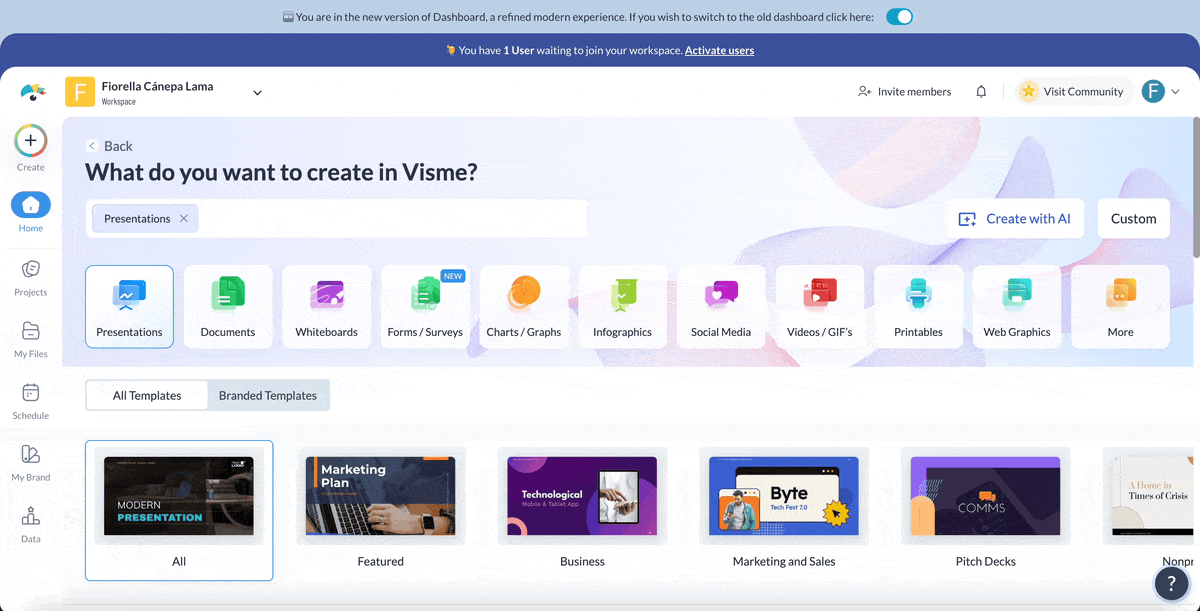
You can quickly personalize your SLAs for each internal department or external client by using Visme’s Dynamic Fields feature. Simply convert sections such as company details, service metrics and responsibilities into dynamic fields and they’ll update automatically throughout the document.
Now it’s time to make the SLA template your own. Break down the list of all services you’ll be providing in your service level agreement model, including their purpose, scope and timeline, and the responsibilities of both parties. This includes:
Be as detailed as possible when outlining these elements. For example, when defining performance metrics, don’t just say “fast response time”—specify “95% of all support tickets will be responded to within 2 hours during business hours.” This level of detail helps prevent misunderstandings and sets clear expectations for both parties.
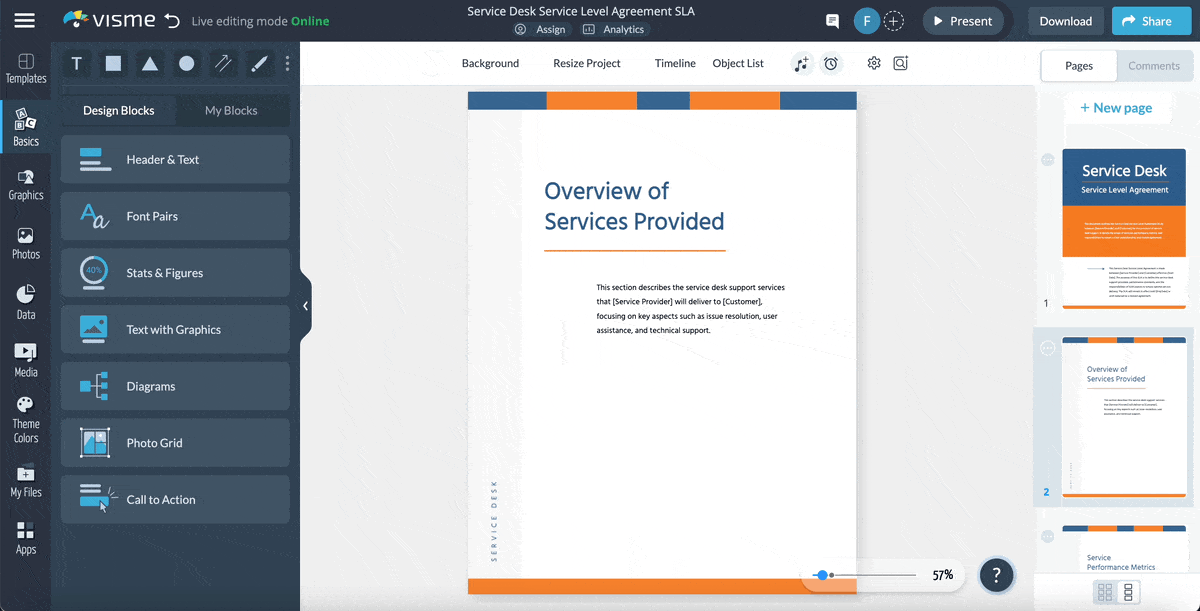 Pro Tip: If you find yourself stuck while writing any of the sections in your SLA, try out Visme’s AI Writer to generate professional first drafts. Simply enter relevant details about your service, and let AI do all the heavy lifting. Don’t forget to review and customize the generated content to fit your brand voice.
Pro Tip: If you find yourself stuck while writing any of the sections in your SLA, try out Visme’s AI Writer to generate professional first drafts. Simply enter relevant details about your service, and let AI do all the heavy lifting. Don’t forget to review and customize the generated content to fit your brand voice.
Remember to align these terms with the goals you identified earlier. Each element should contribute to achieving those objectives. Also, consider potential scenarios that could affect service delivery and address them in your agreement terms. This foresight can save you from future disputes and ensure smooth service operations.
Finally, set up a review process using Visme’s collaboration and workflow features. Tag collaborators, assign specific sections to relevant experts, set deadlines for each stage and track progress within the platform to ensure the document is error-free.
Once all feedback has been incorporated, conduct a final proofread to catch any lingering errors or inconsistencies. Pay special attention to numerical values, dates, and any legal terminology.
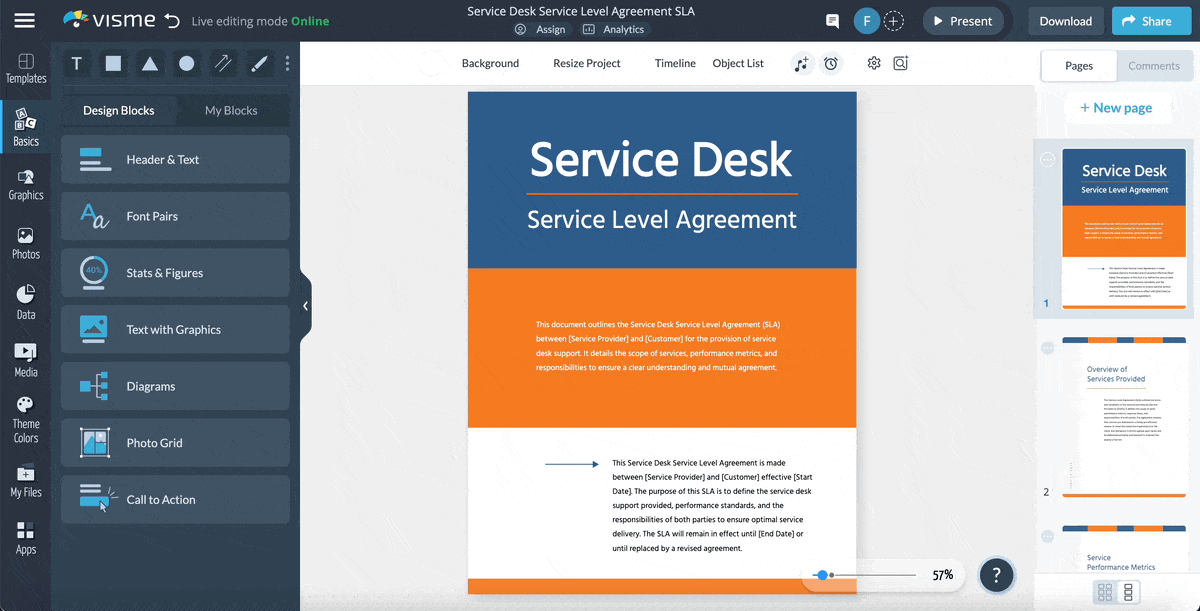
Once you’ve finished designing your SLA, share and publish it among relevant teams, departments and clients via a link or download it as a PDF for offline distribution. You can also track analytics such as total views, average completion, location and organization of all projects published using the ‘Share’ button in the editor. Use these insights to improve your future service level agreements.
Creating SLAs from scratch isn’t easy. But with Visme’s SLA templates, it’s a breeze.
Here are eight service level agreement templates you can use to draft winning agreements quickly.

This HR SLA template is ideal for HR professionals and department heads looking to establish clear service expectations. This sample service level agreement template features a professional layout with well-structured sections for introduction, content overview, services provided, performance metrics, and agreement signatures—everything that’s required in a well-rounded service level agreement.

This SaaS service level agreement example has a clean design with plenty of whitespace and dedicated sections on performance metrics, response times and issue-handling procedures. It features a nice dark border with an icon in the corner, giving the document a professional look.
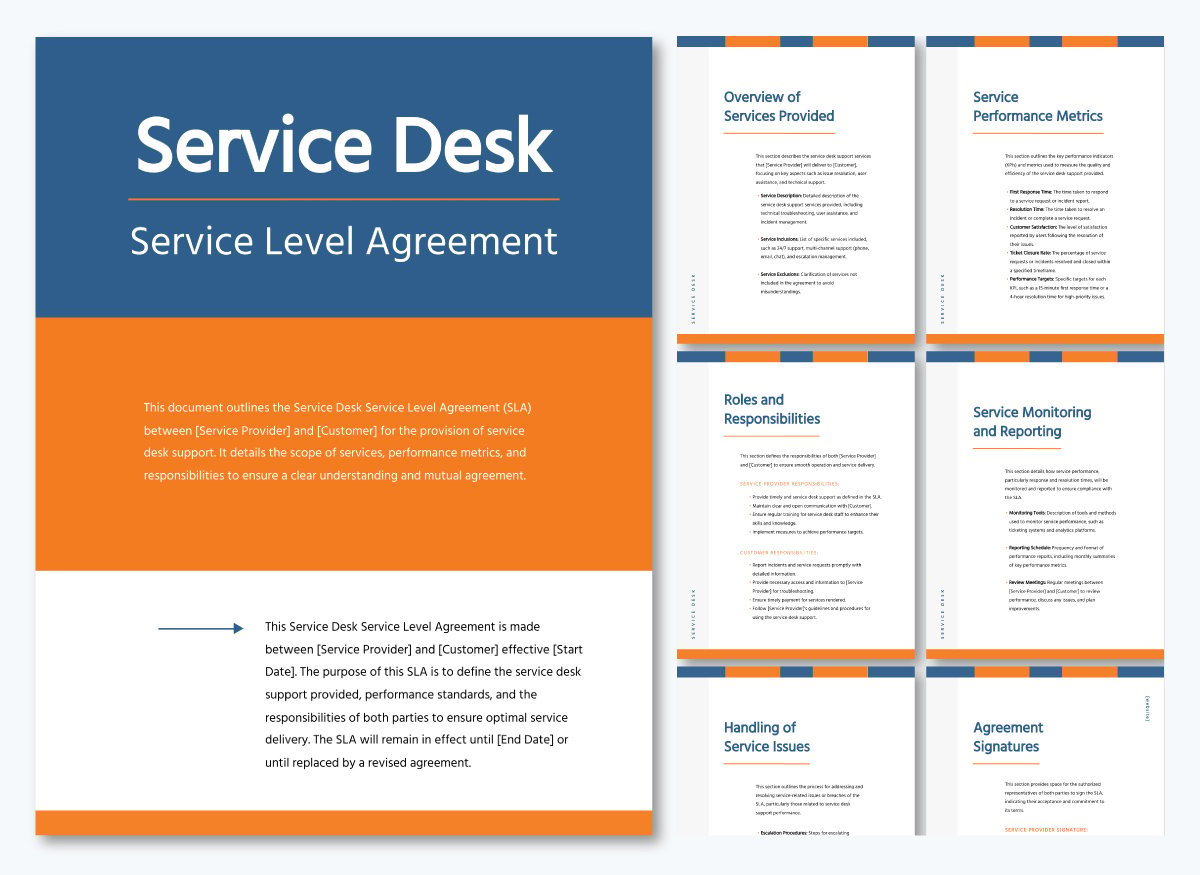
This service desk SLA template features well-organized sections, blue and orange color combinations and a selection of readable fonts.
The service level agreement layout is ideal for a variety of businesses looking to communicate their service standards and expectations with clients.
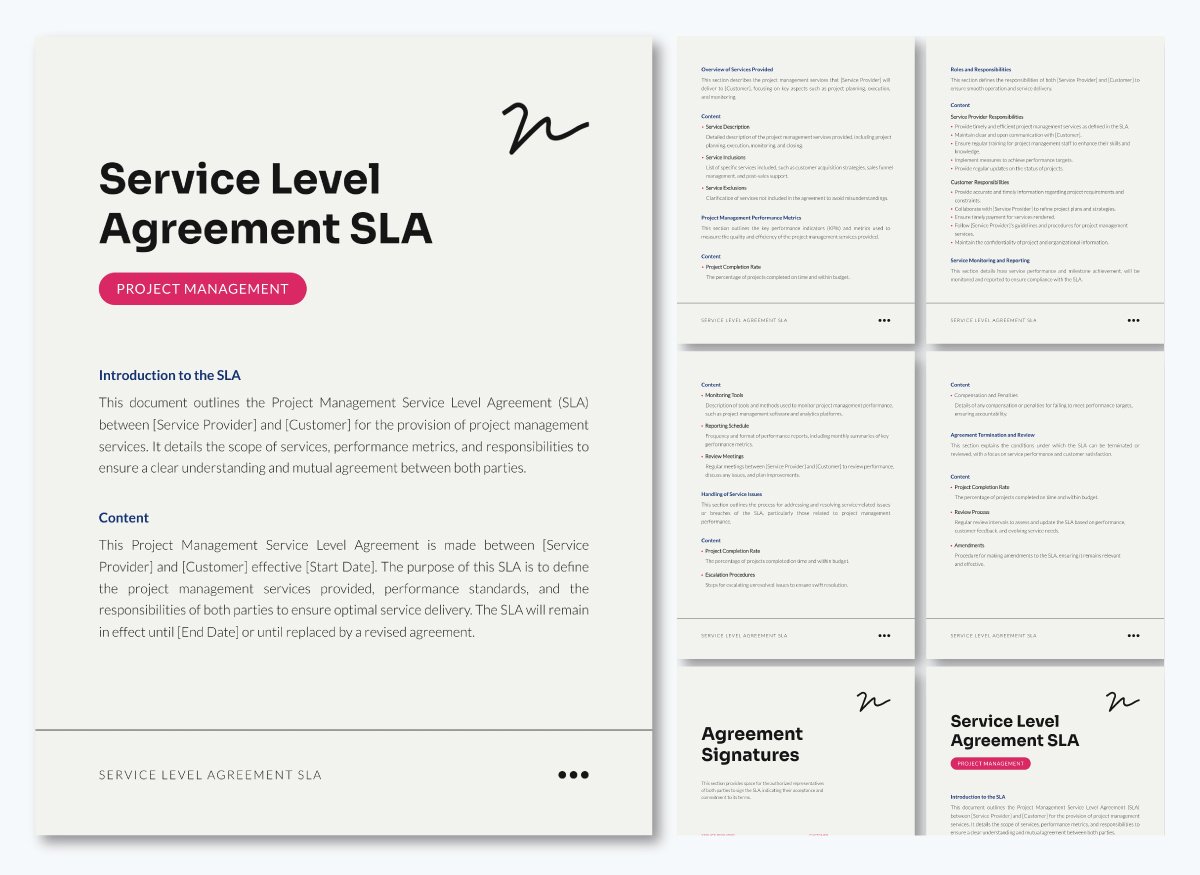
Specially designed for project managers and clients wanting to draft professional agreements, this SLA template offers a clean, minimalist design with ample white space for easy readability.
Instead of manually uploading your branding assets to this SLA template, automate this process with Visme’s brand design tool. Simply input your website URL and let AI automatically pull your colors, logos and fonts to create branded templates. This is also useful when you’re creating multiple SLAs—it helps you save time and maintain brand coherence.
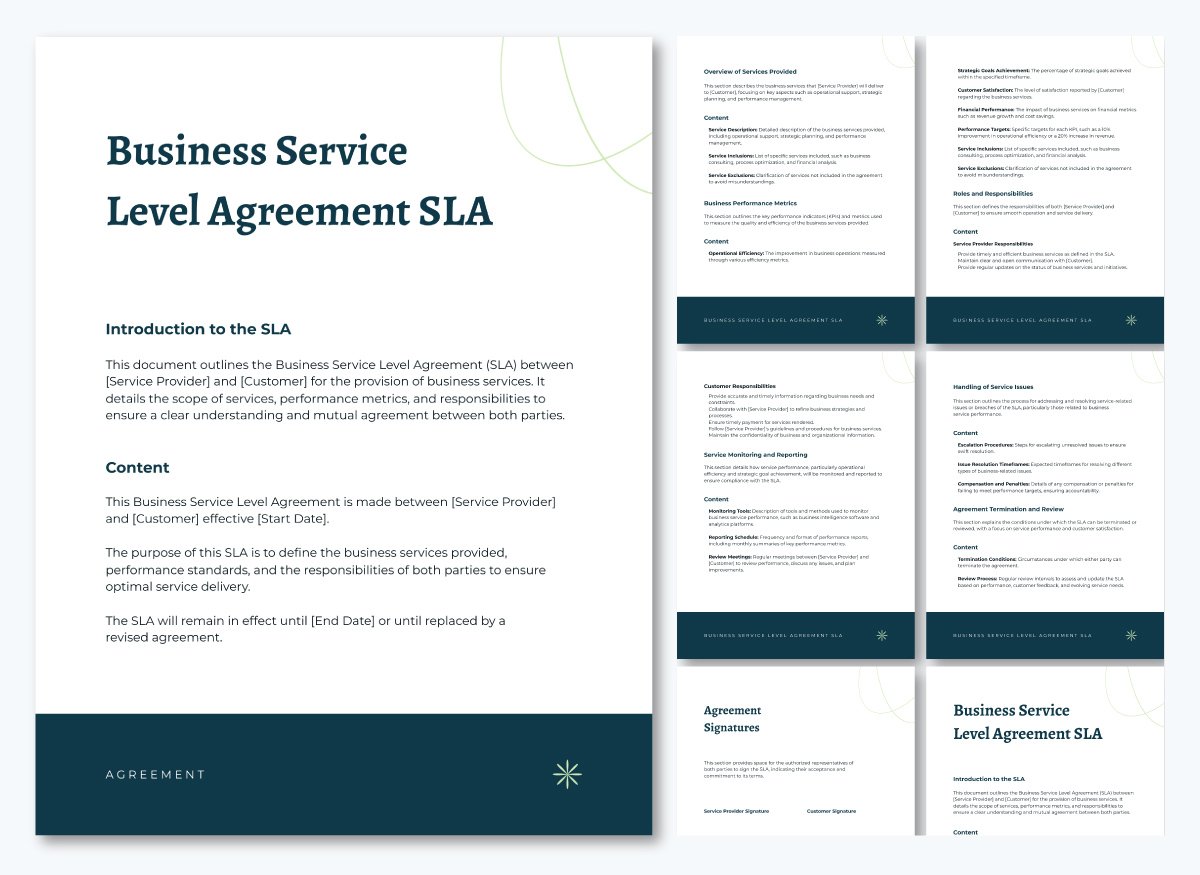
This business SLA template is one of the best service level agreement examples for professional service companies. It features an eye-catching design with a dark footer accent and pre-designed sections on service overview, performance metrics, roles and responsibilities, issue handling and more.
Take your service level agreement to the next level by adding animation and interactivity to your content. Browse our asset library to find on-theme icons and replace bullets with relevant icons, or add hi-res images in the background to create a great impression in front of your clients.
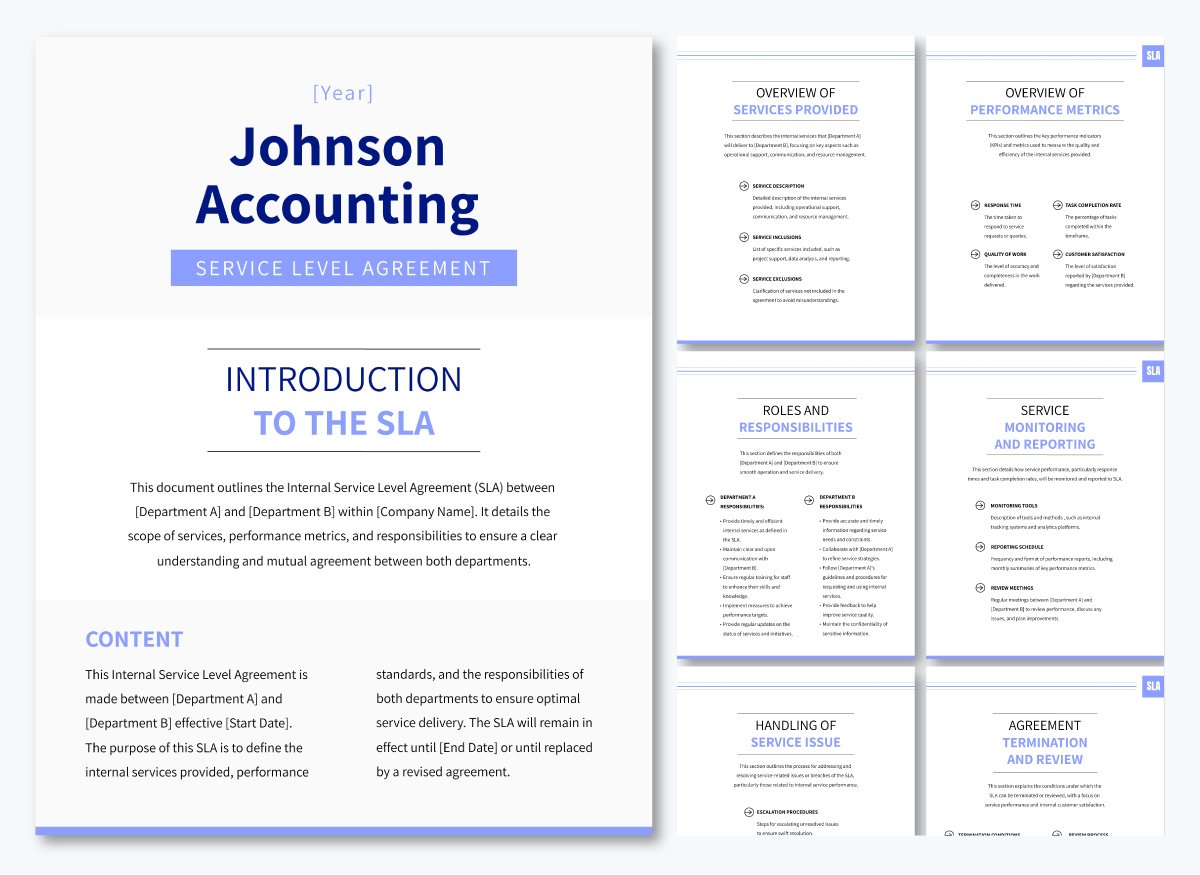
This internal service level agreement template comes with a sleek border, colorful fonts and ample whitespace to make it readable. The layout is ideal for financial services companies presenting SLAs to clients or internal departments.
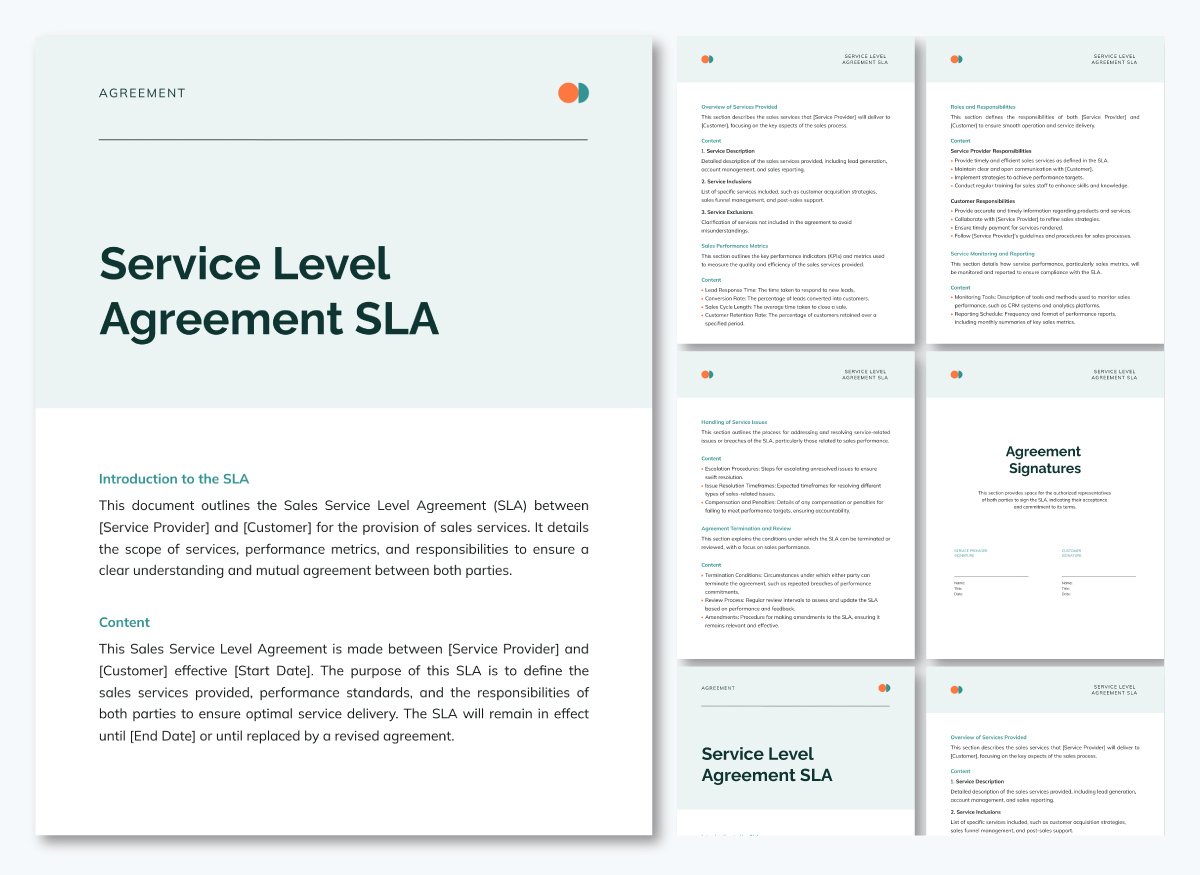
This sales SLA template features a minimalist design with subtle orange accents and well-structured sections on services, responsibilities, metrics and signatures. It’s ideal for a variety of industries wanting to establish formal agreements with their clients.
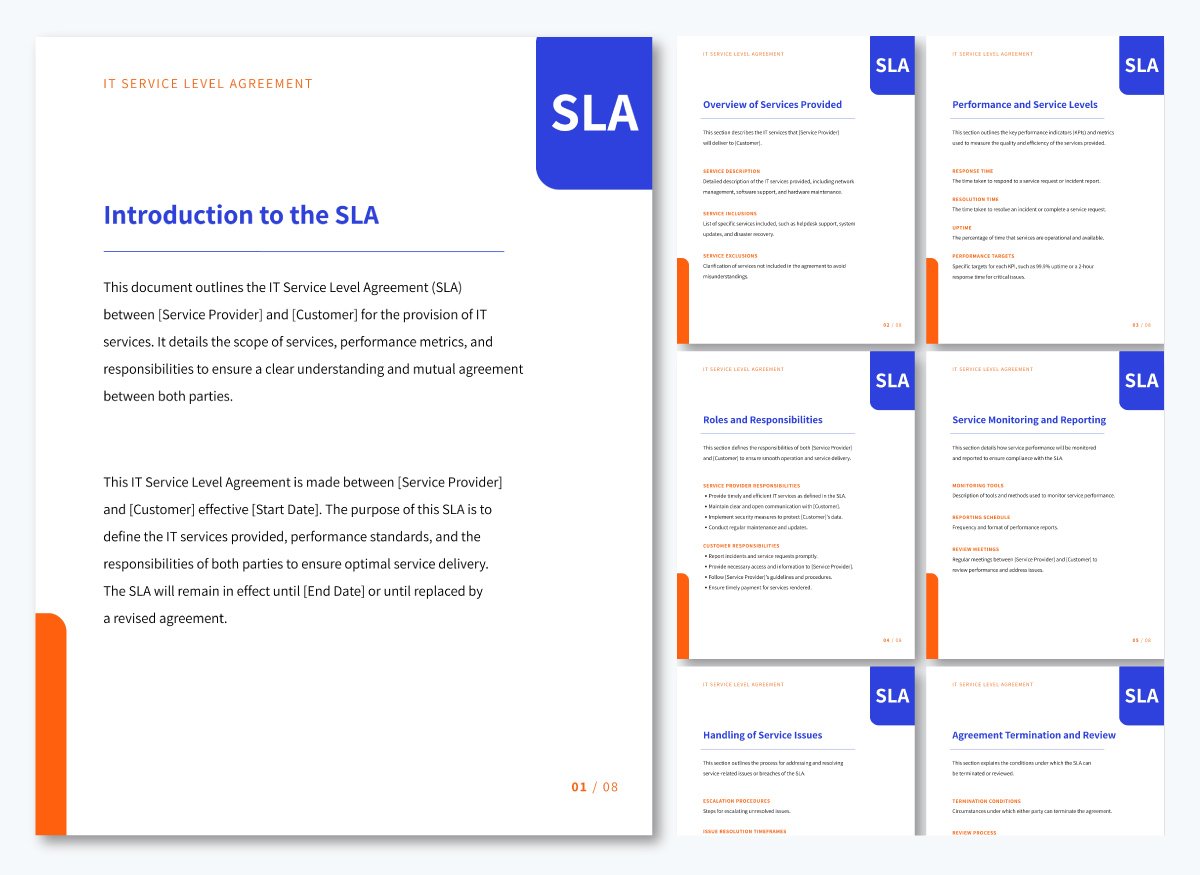
This IT SLA template comes with a tech-themed design with a blue and orange color combo, clear section headers and concise content blocks. It’s an ideal pick for IT service providers and other tech-focused service providers looking to sign binding agreements with their clients or internal departments.
The metrics you choose to track are greatly influenced by the nature of the service being provided and the specific goals of both the service provider and the client.
Here are some key metrics to consider:
Made with Visme Infographic Maker
How to calculate it: (Total Time - Downtime) / Total Time x 100
This metric measures the time a service is operational and available to users. It’s usually calculated as a percentage and is important for services that need to be accessible 24/7, such as e-commerce platforms or cloud services.
High availability ensures users can access the service when needed, directly impacting user experience and business operations.
For example, 99.9% availability means the service can be down for up to 8.76 hours per year. This is considered too high for successful e-commerce businesses. They usually aim to achieve an uptime of 99.99%, 99.999% or even more.
How to calculate it: (Number of Defects / Total Units Produced or Transactions) x 100
This metric is used to assess the quality and reliability of the product or service. Low defect rates indicate high-quality service delivery, which directly impacts customer satisfaction.
For instance, a defect rate of 0.1% in a software application means that only 1 in 1000 operations results in an error. Many high-performing services aim for Six Sigma quality, which translates to a defect rate of just 3.4 defective parts per million opportunities (DPMO).
How to calculate it: (Number of Abandoned Requests / Total Number of Requests) x 100
This metric tracks the percentage of users who give up or “abandon” a process before completion. It’s particularly important for services with user interactions, such as customer support lines or online checkout processes.
In this case, a low abandonment rate indicates that users find the service easy to use, directly impacting business outcomes.
For example, an abandonment rate of 20% on an e-commerce checkout page means that 1 in 5 potential customers leave without completing their purchase. The sweet spot to aim for is an abandonment rate anywhere below 10% to maximize conversions.
How to calculate it: Sum of all response times / Number of requests
This metric—usually measured in seconds or milliseconds—measures the time it takes for a system to react to a specific request. It’s critical for user-facing services like websites or applications, as it directly impacts user experience and satisfaction.
For instance, in 2006, Amazon found that every 100ms increase in page load time cost them 1% in sales. And Google found that a 0.5-second delay caused a 20% decrease in repeat traffic.
Many web services aim for response times under 200ms. However, this can vary depending on the type of application and user expectations.
How to calculate it: Sum of Resolution Times / Number of Incidents
This metric measures the average time it takes to fully resolve an incident. It’s usually measured in hours or days and is key for evaluating overall support efficiency.
A low MTTR indicates effective problem-solving capabilities and, just like most metrics, it greatly influences customer satisfaction.
How to calculate it: Varies depending on the specific business goal, e.g., (Revenue Generated / Target Revenue) x 100
This metric ties service performance directly to business outcomes such as total revenue generated, cost savings achieved or new customers acquired. Keeping track of these results helps you find out whether the service is delivering tangible value to the organization.
Creating an effective service level agreement requires more than just listing out terms and conditions. Here are some service level agreement best practices to consider:
SLA rules are the overarching terms and conditions of the agreement. This includes the scope of work, goals and responsibilities of both parties, performance metrics and potential penalties in case of non-compliance.
SLAs are typically provided by the service provider, as they already have standard SLAs that reflect various service levels at different prices. The contents of the SLA are then discussed and finalized by both parties for a final version.
Follow these best practices to create a successful service level agreement:
The key components of an SLA are:
An SLA strategy is like a game plan for creating and managing service agreements. It involves setting clear, measurable targets, regularly reviewing results and finding ways to improve service delivery.
An indemnification clause is a binding agreement that protects the rights of both parties in case of a breach of service level agreement. For example, if one party fails to meet the agreed-upon service levels and that results in financial losses for the other party, the indemnification clause would come into play.
It specifies the conditions under which one party will compensate the other for losses or damages.
Here are some key metrics to consider:
A properly crafted service level agreement (SLA) can protect the interests of both your client and your organization. If you’re creating one for the first time, keep this handy guide nearby to ensure you don’t miss out on any important information.
Additionally, use Visme to build your SLA in a fraction of the time it would take otherwise to draft one from scratch. Use pre-made templates that come with original content—just swap out the text according to your specific requirements.
Easily apply your branding, invite team members to work on the document together, and even leverage AI-powered tools to generate text and images, edit photos, create custom designs and speed up the entire process.
Sign up for a free account and start creating your service level agreement today.
Design visual brand experiences for your business whether you are a seasoned designer or a total novice.
Try Visme for free